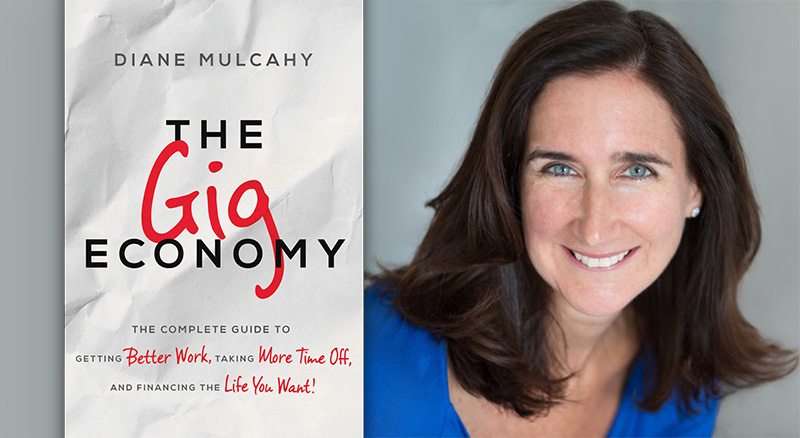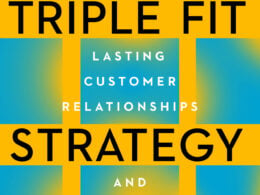Traditional full-time jobs are insecure, increasingly scarce and filled with employees who wish they were doing something else with their lives. Working in the gig economy, as a consultant, contractor, freelancer or part-timer, can offer an entrepreneurial, challenging, flexible, even lucrative and secure alternative to the corporate cube.
Diane Mulcahy has been working in the gig economy for the past decade, and has taught a popular and award-winning MBA course on the topic for the past five years. Her book, “The Gig Economy: The Complete Guide to Getting Better Work, Taking More Time Off, and Financing the Life You Want” is the new career and life guide for navigating and succeeding in this new world of work.
The following excerpt is adapted from “The Gig Economy: The Complete Guide to Getting Better Work, Taking More Time Off, And Financing the Life You Want” Copyright © 2016 by Diane Mulcahy. Published by AMACOM Books.
Building a portfolio of gigs
Diversifying means building a portfolio of different gigs. The most common approach to building a portfolio is to start with the gig that pays. For many readers, a full-time job or a significant contract assignment is the anchor gig of the portfolio. Most jobs are short term (median tenure is less than five years for mostage groups) and all jobs are insecure, so that gig will change overtime. Adding other paying gigs can increase our sense of security and limit our financial downside by providing an income cushion.
But not every gig in the portfolio has to be, or even should be, one that pays. Gigs don’t have to generate income to deliver value. They can be projects or volunteer positions that allow us to explore an interest, learn a skill, rekindle a passion, cross something off the bucket list, or simply participate in an activity that gives us joy. The reasons for pursuing any given opportunity vary as much as the opportunities do.
Almost every gig will help us develop and hone our skills, expand our networks, and position us for a future opportunity.
Gail Simmons majored in anthropology and Spanish in college because those were the subjects she enjoyed and was interested in, but, as she says, “I’ve come to realize, 20 years later, that food is anthropology. What I’m really most interested in is how food is a window into culture. . . . And how we eat is so indicative of who we are.” Anthropology turned out to provide a strong foundation for her interest in food. Of her major in Spanish, she points out that she works in the food industry in New York City. “What’s the language of the kitchen?” she asks. That’s right: Spanish.
We can’t always tell what gigs, what skills, or what experience will matter most to us later or will prepare us for the perfect opportunity. The best we can do is follow our interests and curiosities and do our best to satisfy both.
As you consider how to build your own diverse portfolio of gigs, think about including ones that help you do the following:
Gigs to get your foot in the door
Many of us dream of doing something with our lives that looks completely different from what we’re doing right now, but we’re not quite sure how to make the transition to break into a new field. If that’s the case, find a gig that offers the opportunity to begin the process of meeting, interacting and forming connections with people in a new industry or sector.
For example, Katherine was working full time at an advertising agency, but she constantly found herself sketching the perfect living space in her head. Her true passion was interior design, not advertising. Katherine had no contacts, network or experience in the design industry, but she had plenty of determination, so she went out and got a part-time job working weekends at a high-end furniture store. This gig gave her a way to begin establishing connections in the local interior design industry. She got to know her colleagues, many of whom were well-connected designers, and she met designers who came into the store to shop for clients. Just by being around other interior designers, Katherine was able to ask questions and start learning the basics of the business: how to pitch clients, how much to charge, how to scope and manage projects and what the common mistakes were. After working at the store for a while, Katherine was hired by her first client. Less than a year later, she left her full-time job and started her own interior design firm, which is still going strong. Her part-time job in retail was her foot in the door to learning a whole new industry and launching her own business.
Related: Embracing the Unknown is Key to Constant Creativity [Book Excerpt]
Gigs to experiment
Having a portfolio of gigs allows us to create low-risk opportunities to experiment with new ideas and new opportunities. An experimental gig lets us test an opportunity and if we find we don’t like it, we can drop it and try something else.
By using gigs to create small pilot tests of opportunities, we create the option to either continue and invest more if it’s successful or stop and move onto something else if it’s not.
We limit our investments of time, money and resources, yet still obtain valuable information and learn about what worked and didn’t, what we liked and disliked.
Jill is a good example of someone who experimented through a side gig. Jill was in a fast-paced corporate legal position in New York City. After a decade at the same firm, she felt it was time to move on and was considering moving from the corporate world to working with startups. To explore the entrepreneurial ecosystem, she started by attending a Startup Weekend and working alongside a group of entrepreneurs to develop and pitch a business idea. She rented a short-term desk in a coworking space as a way to meet entrepreneurs. She began acting as a pro-bono legal adviser to several startups, which helped her become familiar with the legal problems they faced and develop experience solving them.
Jill ultimately decided to return to working for a large company, but her experimental work with startups broadened her business and legal skills, expanded her network, and gave her more professional career options. Jill’s example illustrates that side gigs don’t have to develop into full-time positions to be considered successful. Instead, they can give us valuable information to make better decisions about our next steps.
Gigs to learn by doing
We can build a portfolio of gigs that gives us opportunities to learn on the job, at our own pace, in lower-risk situations. For instance, when I first became a part-time adjunct lecturer, I was a nervous and novice public speaker. The idea of getting up at a professional conference and speaking to a large audience of colleagues was very stressful to me. Yet I felt relatively less stressed and safer in front of a group of students, teaching a course I created, and talking about a subject I knew well. Through my side gig as a lecturer, I practiced speaking every week that I taught class, and I was able to experiment with a variety of speaking techniques, find my own voice and request feedback from colleagues and students. By the time my day job required me to take on more public speaking responsibilities, I was practiced and comfortable enough to smoothly transition to that role. My gig as a lecturer gave me the chance to learn public speaking by doing it.
Related: Sign up to receive the StartupNation newsletter!
Gigs to do what you really want to do
We can build a portfolio of gigs to make sure we do the things we’ve always wanted to do and help us avoid the deferred life plan. The deferred life plan refers to our tendency to focus first on things we “should” do or are expected to do, while deferring the things we really want to do until. . . someday (which may or may not arrive). Living the deferred life plan is risky. There’s a significant chance that we’ll get so caught up in the identity and trappings of the life we’re leading (the title, the compensation, the position) that we’ll later find it difficult to separate ourselves and step away to do the things we want to do.
We also expose ourselves to the possibility of goal creep. For instance, we assure ourselves that we’ll work as a corporate lawyer or investment banker until we hit our number (the amount of money we want to have), but half a decade later we’re completely caught up in the lifestyle and the number we think we need to achieve starts getting higher. The constantly moving goalpost of the ever-increasing number means we’ll never feel satisfied enough to stop what we’re doing and shift to what we want to do.
A portfolio of gigs can help us avoid deferring our lives by giving us a way to pursue the things we really want to do starting today.
“The Gig Economy” is available now at fine booksellers and at StartupNation.com.
Reviews of “The Gig Economy”
“Essential guidebook to navigating the gig economy…This highly recommended guide will have wide appeal.”
–Library Journal, starred review
“‘The Gig Economy’ gives the reader an inroad to life-changing choices…sure to be popular with students and others at all stages of life and career who are ready to make a change.”
–Booklist
“The book provides a wealth of excellent how to advice on succeeding at independent work…well worth reading for anyone considering becoming an independent worker.”
–Small Business Lab
“Anyone considering making the jump into the gig economy should read Mulcahy’s book. It explains why it makes sense and details many of things you need to know.”
–Forbes






